Science & Technology - 2015
October
Shaping NIF’s Beams for Direct-Drive Experiments
HAPLS Completes Phase 1 Energy-Ramping Campaign
LLNL’s High Repetition Rate Advanced Petawatt Laser System (HAPLS) project reached a key energy milestone on Oct. 21, when the HAPLS pump laser system produced 71 joules of infrared laser energy and 41 joules of second-harmonic (green) energy.
The pump laser is a main component of the HAPLS system, and energizes the final power amplifier of the short-pulse beamline. When fully commissioned, HAPLS will be the world’s highest average power petawatt laser system. HAPLS is being designed, developed, assembled and tested at LLNL for delivery to the European Union’s Extreme Light Infrastructure Beamlines (ELI-Beamlines) facility in the Czech Republic.
Ramping of the HAPLS laser, and in this case the pump laser, is organized in several phases which are set forth in the agreement with ELI-Beamlines and is based on a conservative and stepwise approach to commissioning HAPLS to its full design performance. Achieving 71 joules of infrared energy and 41 joules at the second harmonic marks the completion of the first energy-ramping campaign, which exceeded the required energies by 11 joules in the infrared and six joules in the second harmonic.
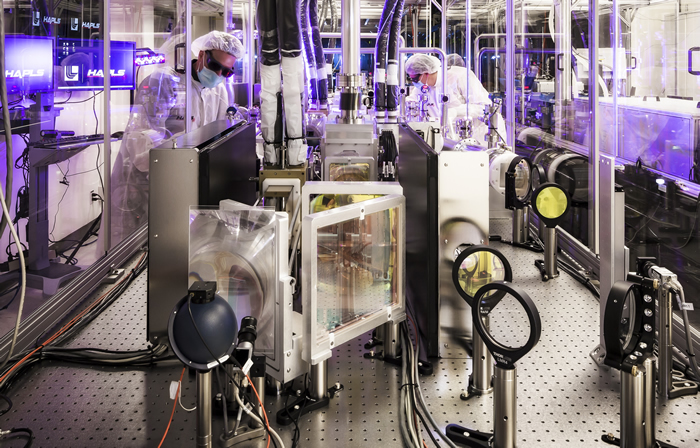 Jeff Jarboe (left) and Andy Bayramian check alignment on the diode delivery system on the HAPLS pump laser power amplifier. Credit: Damien Jemison
Jeff Jarboe (left) and Andy Bayramian check alignment on the diode delivery system on the HAPLS pump laser power amplifier. Credit: Damien Jemison The energy ramping was conducted with shots every five seconds in a “single shot” regime, as opposed to an average power regime in which the amplifiers are thermally loaded and thermal effects need to be mitigated. HAPLS uses helium-gas cooling to extract the heat from the amplifier gain material.
The HAPLS team’s next ramping milestone is to repeat the same amount of energy extraction at a repetition rate of 3Hz (three shots per second) in keeping with the project’s phase 1 ramping guidelines. Gas cooling and heat extraction already has been demonstrated on the HAPLS pump laser amplifiers. Completion of those milestones will prepare the facility to integrate the pump laser with the short-pulse beamline.
In the second ramping phase, the short-pulse beamline will be ramped following a similar approach as for the pump laser. Once that is complete, the laser will be transported to the ELI Beamlines facility and integrated with the ELI pulse compressor before ramping to full design performance is begun.
“This is great progress and marks an important part in the commissioning of HAPLS,” said Constantin Haefner, program director for Advanced Photon Technologies. “HAPLS is being realized through the extensive subject matter expertise in the NIF & Photon Science and Engineering directorates and close collaboration with ELI Beamlines.”
The ELI Beamlines facility was officially inaugurated in ceremonies on Oct. 19, marking the conclusion of the project’s initial implementation phase. LLNL Deputy Director for Science and Technology Patricia Falcone, who attended the ceremonies along with Haefner, said, “We are excited to be working with our colleagues on realizing new capabilities for lasers, and looking forward to great scientific results from this wonderful facility.”
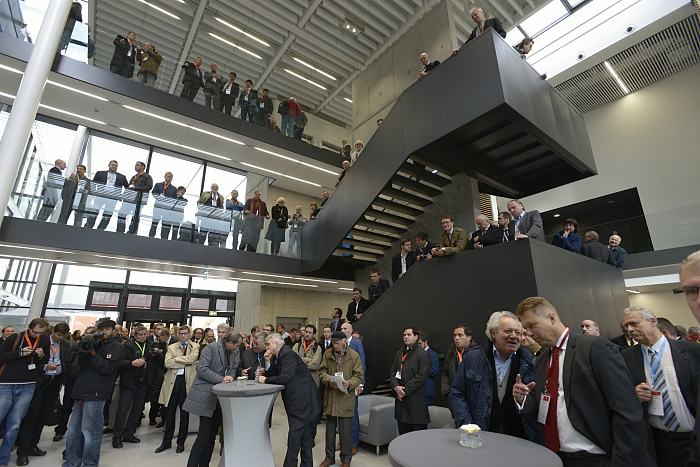 Guests from the worlds of science and politics gather in the lobby for the dedication of the ELI Beamlines facility in Dolní Břežany in the Czech Republic.
Guests from the worlds of science and politics gather in the lobby for the dedication of the ELI Beamlines facility in Dolní Břežany in the Czech Republic. The facility’s laser hall is being prepared for installation of new laser and experimental technologies beginning next year. The entire complex will be available for user research starting in 2018.
“ELI as a whole will be the world’s first international laser facility,” said Wolfgang Sandner, Director General of the ELI-DC International Association, “hosting today’s most sophisticated and most powerful lasers. It will attract the best scientists from all over the world to perform experiments at the frontier of science. Our vision is to make it the ‘CERN of laser research.’”
Bedřich Rus, chief scientist of ELI laser technology, noted that several world records already have been broken during the development of the project’s laser systems, including the world’s highest peak power laser diode arrays developed for HAPLS.
Shaping NIF’s Beams for Direct-Drive Experiments
In a partnership with the Laboratory for Laser Energetics (LLE) at the University of Rochester, NIF researchers have been making important advances in the design and production of beam-shaping continuous phase plates (CPPs) for direct-drive inertial confinement fusion (ICF) experiments.
In laser-driven ICF, there are two ways to achieve the compression of a target required to obtain fusion conditions: direct drive and indirect drive. Most NIF shots to date have used indirect drive—the target capsule is heated and compressed by a uniform “bath” of x rays created by the lasers inside the hohlraum. The x rays are designed to compress the fuel symmetrically, an essential requirement for a successful NIF shot.
Direct drive, in contrast, is a configuration with fewer intermediate steps. Instead of compressing the fuel indirectly via heat from x rays, in direct drive the laser beams are targeted directly onto the fuel capsule. Developing this approach on NIF, however, introduces complications. In order to achieve a spherically symmetric implosion of the fuel, the optimum laser configuration is symmetric: the lasers irradiate the target from every angle. NIF’s lasers, however, currently are positioned on the top and the bottom of the Target Chamber—no beams are located around the target equator. That means the energy that can be imparted onto the capsule near the equator is reduced, potentially limiting the achievable implosion performance.
 Members of the LLNL direct-drive continuous phase plate team (from left): Aaron Peer, Christopher Stolz, Sham Dixit, Matthias Hohenberger (LLE), and Joseph Menapace (front) examine a CPP contour plot and a spot-size calculation of a manufactured phase plate.
Members of the LLNL direct-drive continuous phase plate team (from left): Aaron Peer, Christopher Stolz, Sham Dixit, Matthias Hohenberger (LLE), and Joseph Menapace (front) examine a CPP contour plot and a spot-size calculation of a manufactured phase plate. This is where continuous phase plates play a pivotal role. As optics that can shape the laser beam spatial profile, the direct-drive phase plates are designed to spread the energy of the beams evenly around the target capsule. Here’s how they work:
Phase plates are transparent glass optics that are placed in the beampath in front of the focusing lens in the final optics assembly. By having small, nanometer-scale thickness variations across the optic, the phase plate imparts phase changes to the laser wavefront, which translate to changes in the shape and intensity profile of the focused laser beam. 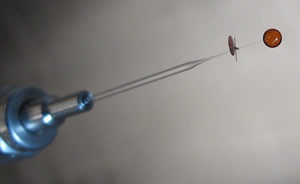 A NIF direct-drive target; the two-millimeter-diameter, 100-micron-thick plastic capsule is filled with 20 atmospheres of deuterium. A copper backlighter target (left of the capsule) is used to radiograph the imploding capsule when driven by the NIF laser in direct-drive mode.Carefully designing the phase plate surface topography enables the production of complicated focal spot shapes tailored to the experimental needs.
A NIF direct-drive target; the two-millimeter-diameter, 100-micron-thick plastic capsule is filled with 20 atmospheres of deuterium. A copper backlighter target (left of the capsule) is used to radiograph the imploding capsule when driven by the NIF laser in direct-drive mode.Carefully designing the phase plate surface topography enables the production of complicated focal spot shapes tailored to the experimental needs.
For recent direct-drive experiments, 2-D simulations were used to determine the energy distribution of the lasers on the target and identify where there may be too much or too little. Iterative changes to the focal spot profiles used in the simulations ultimately converged to an optimized design with uniform irradiation of the entire target, which formed the basis for the prototype phase plates used in the NIF experiments.
These developments in direct-drive phase plate design are essential to NIF’s mission of achieving high-yield implosions. Direct drive eventually could surpass indirect drive in terms of energy efficiency and energy yields, potentially becoming the primary configuration used in science and industry.
Phase plates also are used for beam smoothing and focal spot shaping in indirect-drive configurations, but the CPP design for direct drive is unique. Indirect-drive phase plates are ellipsoid, with the goal of reconfiguring the square laser beam and transmitting it as a circle onto the target, as well as equalizing the energy of the beam so it has the same intensity throughout. Direct-drive phase plates are designed to focus the laser beams to a deformed circle. These phase plates have a remarkable predetermined topography—each piece of glass displays tiny peaks and valleys throughout its surface.
“This allows the direct-drive phase plate to condition the beam in a way that’s different from the indirect-drive phase plates, allowing the beam to interact with the target appropriately,” said LLNL chemist Joe Menapace, who fabricated the phase plates.
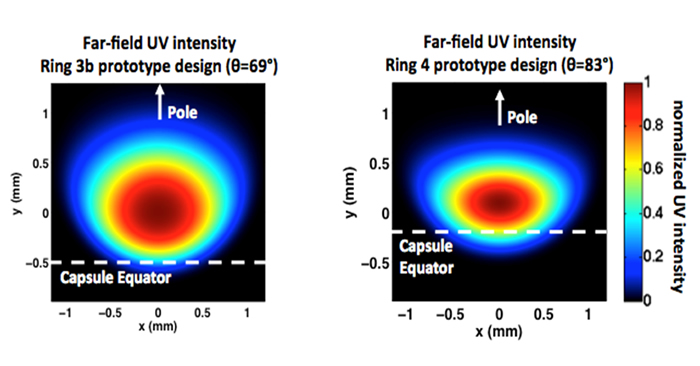 The two images above display two different phase plate spot profiles that are designed to irradiate different parts of the target. The phase plate on the left is incident onto the target at 69°, and the one on the right is incident onto the target at 83° (closer to the target equator, as indicated by the white dashed line). Near the equator, the phase plates are shaped to deliver higher intensities to the equatorial region of the target.
The two images above display two different phase plate spot profiles that are designed to irradiate different parts of the target. The phase plate on the left is incident onto the target at 69°, and the one on the right is incident onto the target at 83° (closer to the target equator, as indicated by the white dashed line). Near the equator, the phase plates are shaped to deliver higher intensities to the equatorial region of the target. The plates are meticulously polished by a magneto-radiological finishing (MRF) tool, which uses chemical and mechanical removal to shape the surface of the plates, removing unwanted glass atom-by-atom to achieve the desired design. Menapace and the team in his lab achieved extraordinary adherence to the phase plate design, yielding plates that came within two nanometers of the desired design.
Recent NIF test shots with a prototype of the new direct-drive design have yielded “great results,” said Matthias Hohenberger, a physicist on the project. “We needed to confirm that these complicated phase plate designs behave correctly and give us the focal spot shapes we need for a symmetric direct-drive implosion,” he said. “Now we know that they do.”
Phase-plate research has been conducted since the mid-1990s. Researchers at LLE developed the initial design, which involves imprinting and/or polishing a phase plate so that it redistributes and transmits the laser’s energy. The latest results were provided by the new prototype—the phase plate project has one more refinement to go through before the team will begin to construct a set of 10 pilot CPPs at the optic vendors.
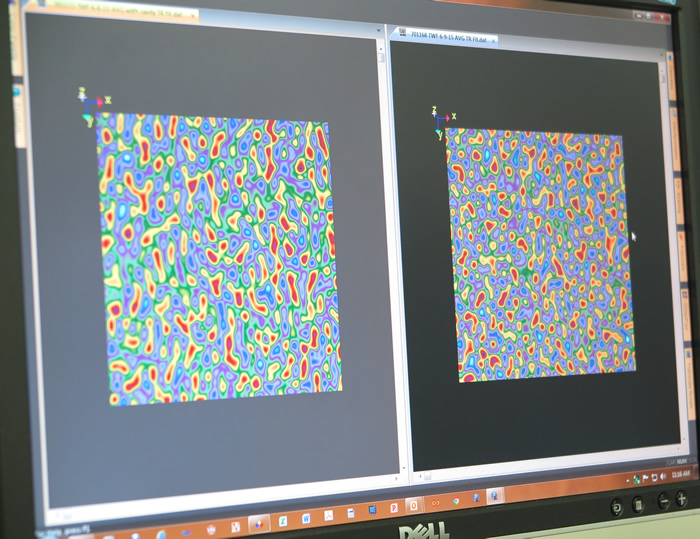 Computer images of the 3D direct-drive phase plate surface topography.
Computer images of the 3D direct-drive phase plate surface topography. The recent success in phase plate design and manufacturing is one example of the strong partnership between LLNL and LLE, a collaboration that has been ongoing for more than two decades. In this case, LLE was responsible for the theoretical design of the phase plates and target modeling. LLNL assisted with sharing NIF phase fronts and design rules for reducing the manufacturing costs in production and imprinting the actual phase plates. And the teams worked together to bring the idea and NIF experiments to fruition.
Hohenberger represents LLE and conducted the NIF experiments that tested the new design. LLNL engineer Chris Stolz managed the project for LLNL, while Menapace and his team manufactured the phase plates with technical support and expertise from Sham Dixit, Aaron Peer, Pascale Di Nicola, and Paul Wegner.
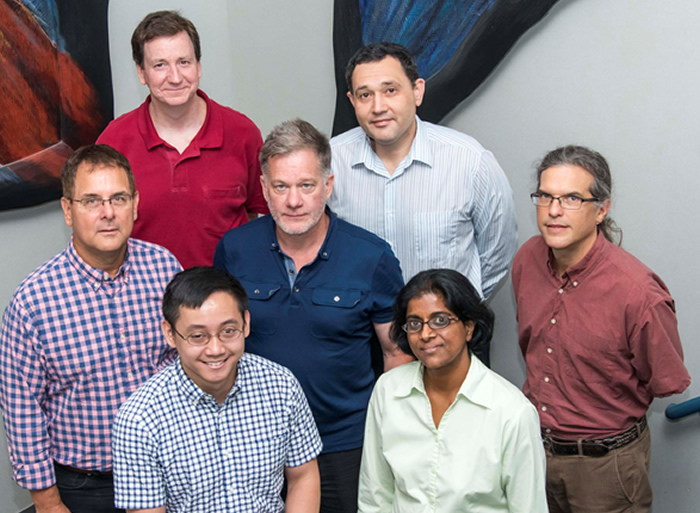 Members of the LLE direct-drive phase plate team, from top left to bottom right: Timothy Collins, Alexander Shvydky, Patrick McKenty, Terrance Kessler, John Marozas, Duc Cao, and Radha Bahukutumbi.
Members of the LLE direct-drive phase plate team, from top left to bottom right: Timothy Collins, Alexander Shvydky, Patrick McKenty, Terrance Kessler, John Marozas, Duc Cao, and Radha Bahukutumbi. The CPP design project has been about a year in the making. “There are a few key steps that need to be taken in order to get direct drive to indirect drive’s level,” Hohenberger said, “and these phase plates are one of those major steps, so we’re very happy with the progress.
“I’m really enjoying my time at the Lab,” he said. “The direct-drive project is a fairly young campaign at the NIF and we’re only just beginning a lot of exciting research, so to be here from the start is very gratifying.”



